

Scaffolding Student Skills For Productive Classroom Discussions. By Jackie A.

Walsh How would you rate the quality of student talk in your classroom? Does it help your kids dig down deeper and learn more? Or do you sometimes feel that it’s not the best investment of class time? Student skills are the means and ends of productive classroom discussions. In turn, when students are deliberate in the use of these skills, they are enhancing their ability to engage in thoughtful discourse in academic settings and beyond—in the workplace and in our democratic society. We can all agree these are important goals, but we also know that most students do not arrive in our classrooms with a high level of proficiency in these skills. What are the most important skills for good classroom talk?
Improving student skills requires focus and intentionality. Capacities Associated with Skilled Discussion (p. 39, Questioning for Classroom Discussion – ASCD, 2015) Student Choice and Viral Videos. When designing a project-based learning (PBL) unit for students, it's important to ask how you can make learning content interesting to your intended audience.
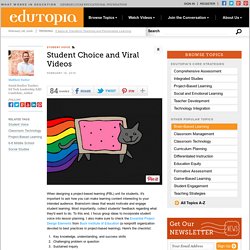
Brainstorm ideas that would motivate and engage student learning. Most importantly, collect students' feedback regarding what they'd want to do. To this end, I focus group ideas to incorporate student voice into lesson planning. I also make sure to check the Essential Project Design Elements from Buck Institute of Education (a nonprofit organization devoted to best practices in project-based learning). 5 Ways Student Choice Impacts Learning. This is the first post in the “Innovative Teaching Challenge” series.
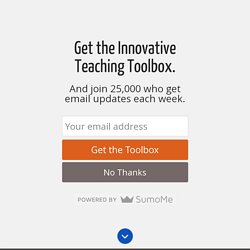
Get each challenge delivered to your inbox by signing up here. Student Choice Leads to Student Voice. The way I understood school learning shifted the first time I was given an opportunity to design a project of my own.
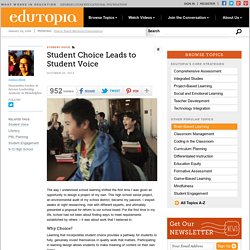
This high school senior project, an environmental audit of my school district, became my passion. I stayed awake at night researching, met with different experts, and ultimately presented a proposal for reform to our school board. For the first time in my life, school had not been about finding ways to meet requirements established by others -- it was about work that I believed in. 5 Ways to Give Your Students More Voice and Choice. The idea of co-constructing knowledge with students can be a scary thing for many of us teachers.
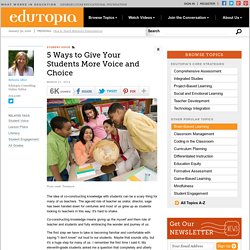
The age-old role of teacher as orator, director, sage has been handed down for centuries and most of us grew up as students looking to teachers in this way. It's hard to shake. Co-constructing knowledge means giving up the myself and them role of teacher and students and fully embracing the wonder and journey of us. The first step we have to take is becoming familiar and comfortable with saying "I don't know" out loud to our students. Maybe that sounds silly, but it's a huge step for many of us. We all just sat there in the silence of those three words. Then I said, "Who knows something about this that they can share? " Two educational theorists who inform my thinking about co-constructing knowledge are Vygotsky and Freire. Yes, it is true that teachers need to be the ultimate decision-makers about a lot of things.
Student Engagement: Resource Roundup. Facebook Edutopia on Facebook Twitter Edutopia on Twitter Google+ Pinterest Edutopia on Pinterest WHAT WORKS IN EDUCATION The George Lucas Educational Foundation.
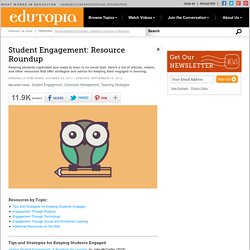
Student Voice And Choice In Language Learning. Volume 2, Issue 11, Number 5 Driving Question: How can student voice and choice enrich language learning?
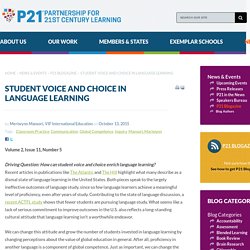
Recent articles in publications like The Atlantic and The Hill highlight what many describe as a dismal state of language learning in the United States. Both pieces speak to the largely ineffective outcomes of language study, since so few language learners achieve a meaningful level of proficiency, even after years of study. Contributing to the state of language discussion, a recent ACTFL study shows that fewer students are pursuing language study. What seems like a lack of serious commitment to improve outcomes in the U.S. also reflects a long-standing cultural attitude that language learning isn't a worthwhile endeavor.
10 Ways to Encourage Student Voice and Choice. Personalize the Learning Environment Building a personalized learning environment means putting the learner first.
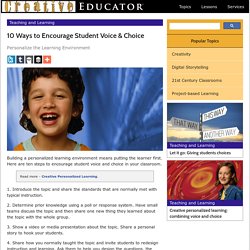
Here are ten steps to encourage student voice and choice in your classroom. 1. Introduce the topic and share the standards that are normally met with typical instruction. 2. 3. 10 Social Media Sites For Education. 10 Social Media Sites For Education by Lila Daniels Our kids live on social media these days.
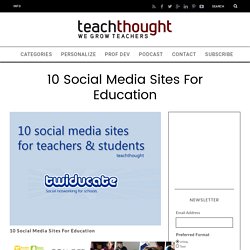
One crucial way to make learning relevant is to meet ’em where they live, which means finding social media sites that work in the classroom. Social media organically dovetails with subjects like language arts and social studies, but tech savvy teachers know that collaboration can work in any classroom. Not all social media sites are equal — and not everyone is comfortable turning their students lose on Facebook or Twitter. Ep. 14: Elevating Student Voice With The #StuVoice Movement. -
Ep. 14: Elevating student voice with the #stuvoice movement. by Drew Perkins This is episode 14 of the TeachThought Podcast!

Become a Listening Educator: How to Hear and Connect to Your Students. Sure, you can hear the words that are coming out of your students’ mouths. But are you really listening to them? No matter how much you love your students, it’s not an easy task with so many of them in front of you and so many duties to balance. And yet, nothing is more important than making that personal connection.
What the Connected Learning Research Community Can Learn from YPAR - DML Central. Last month, the two of us (along with our mentor, Dr. Ernest Morrell) celebrated the release of our book, Doing Youth Participatory Action Research: Transforming Inquiry with Researchers, Educators, and Youth. The book tells the story of the UCLA Council of Youth Research (YPAR), a long-running youth participatory action research program that mentors young people from South and East Los Angeles to develop research questions about the educational and social challenges they recognize in their communities and then conduct rigorous inquiry into those questions for the purposes of fostering empowerment and action for social justice.
We drew on our membership in the Council community to detail one year in the life of the program and use this portrait as a lens through which to explore YPAR as a radical vision of knowledge production that can transform how educational researchers approach their work — particularly those in the connected learning community. What is research? 3 Practices to Promote Equity in the Classroom. I recently observed a classroom where students were presenting history projects to rows of silent and obedient classmates.
Though the projects were diligently constructed, I couldn't focus on their content because I was distracted by two facts: only the teacher was asking questions, and he kept calling exclusively on girls to present. Ten minutes later, I walked into a completely different classroom where students rotated through the room presenting group projects to each other. The teacher instructed his class to "work to understand" the content through discussion, and every voice filled the room. These two experiences resurfaced a long-held question: What makes for an equitable classroom? While this topic deserves a whole book, here are three simple practices that you can try on to increase the range and frequency of student voices in your classroom.
Practice 1: Use Equity Sticks Equity sticks are a cheap and powerful way to check your biases at the door. Photo credit: Shane Safir. A Self-Directed Learning Model For 21st Century Learners. A Self-Directed Learning Model For 21st Century Learners by Terry Heick The above is the latest draft of our self-directed learning framework, version 1.1. It is based, in spirit, on our Inside-Out School: A 21st Century Learning Model. The Missing Voices in EdTech.
Today’s Education Should Be About Giving Learners Voice and Choice. Student Voice Comes With Teachers as Listeners. Why Learning Innovation Can't Come From Teachers Alone. Why Learning Innovation Can’t Come From Teachers Alone. 4 Ideas for Building Student Voice and Choice in Language Learning. Posted 10/26/2015 8:51AM | Last Commented 11/06/2015 6:46AM Image Credit: Meriwynn Mansori. 15 Examples of Student-Centered Teaching. Growth Mindset: Clearing up Some Common Confusions. By Eduardo Briceño A growth mindset is the understanding that personal qualities and abilities can change. It leads people to take on challenges, persevere in the face of setbacks, and become more effective learners. As more and more people learn about the growth mindset, which was first discovered by Stanford Professor Carol Dweck, we sometimes observe some confusions about it. 20 Tips To Promote A Self-Directed Classroom Culture. Student Voice Ideas and Issues.
CommonAction Consulting: 51 Ways to Tokenize Student Voice. Student Voice. #Edchat Weekly Roundup: Student Voice. One of the most commonly used education hashtags (asides from #edchat) is #stuvoice. 4 Steps to Empower Student Voice. Student voice. Student voice. Educación Inclusiva. The Student Voice and a Framework for Learning Technology. Building Student Voice Through a Student Bill of Rights.